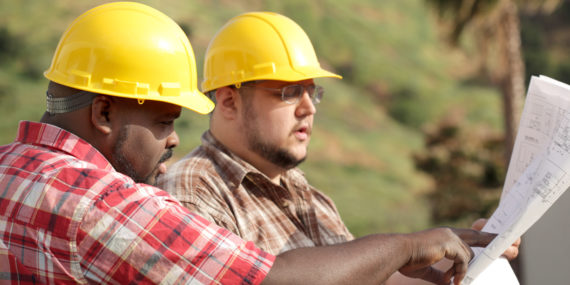In “A Foreman’s Approach to Working with New Employees: Day 1,” the first of a four part series, I pointed out several efforts that a Foreman might make with a new employee on their first day of work. From a sincere handshake, to introducing the new worker to their new teammates, to putting the new worker on some of the easier, yet important tasks, all the recommendations were done to allow both the new employee, and the Foreman, a chance to assess each other and to encourage a positive first day impression, for both individuals.
Though first impressions made on the first day of work are important, the remaining days of the first week are also “mission critical” to keeping the new employee engaged and interested in the company. The Foreman is the primary leader who has the most impact on this first week. If a great first impression is made on Day 1, then the rest of the week must continue the positive and supportive atmosphere that was initiated. If a poor first impression was made, and the new employee returns for Day 2, the Foreman has his work cut out to improve both the impression and the sincere interest in the worker to stay.
In this second article, we move to Day 2 – 5, transitioning the new worker in a methodical and encouraging trend toward better understanding the company, the crew, and his or her position. Therefore, let’s continue our effort to strengthen the actions of a Foreman to make the first week the best first week possible for the new worker.
- Maintain Clear and Consistent Communication

Among the observations about many Millennial employees entering the job market, one of the highly desired need of this age group (i.e. approximately 18-34 years of age) is their need for communication. This includes both being communicated to by others and to be allowed to communicate with others. This doesn’t suggest that all younger workers want talk more than anything else, it does point to a need for understanding, acceptance, and direction. Such things come as a result of communication. The Foreman should feel free to engage the new employee throughout the day as opportunities arise. From just passing by the new worker and saying, “How’s it going Jose?” to reminding the worker, “Hey Tommy, holding the lute this way will give you a better pull without straining your back!” It’s the simple daily interactions that reinforce the openness for communication.
- Teach the “Why” Along with the “What & How”
Yet another bit of insight from some national studies done on younger workers points to the interesting fact that they want to know “Why” things are done in a particular way. I’ve had Foremen complain to me about having workers who want to know “Why we have to do it this way,” or “Why we have to do it that way.” My response is always the same, “You should be glad the employee is asking for the ‘Why’ because that us the door opening to actual learning.”
This second point is huge in the development of any worker. When one understands the “Why” behind a task or process, suddenly the mechanics of actually doing the task becomes clearer and justified. Thus, the Foreman, if they will begin their teaching with first addressing the “Why” behind the task, will garner more understanding, sooner, and satisfy the question that will plague the new worker until they know the reason behind the movement.
A final thought on teaching the “Why” is that this often provides the foundation for what is required by law or is performed to provide the best short-term or long-term safety, or it may just separate our company from another company. Foremen should not get upset when a new worker is asking “Why,” but instead, be thankful that the worker is showing interest to better understand the importance of learning things the right way. Foremen, don’t roll your eyes or dismiss any worker’s interest in knowing “Why” something must be done, this is part of most long-term learning development.
- Check-In Daily with the New Worker
The regular check-in will serve as a reminder that you care, that you are interested in the new worker’s acceptance to the crew, and that you are always available to answer questions. How often the Foreman checks-in with the new worker is dependent on the work situation, but checking-in two or three times during the day is a good idea. I would recommend always at the start of the day, once throughout the day, and then just before the crew is packing up for the day. This provides the Foreman the chance to see how the new worker is doing first thing in the morning, do they look tired or do they have any questions before starting work. There will probably be multiple interactions during the work day related to learning a task or technique, but the Foreman should make it a point to specifically ask the new worker how they are handling the day thus far and do they have any questions. Finally, checking-in at the end of the work day allows the Foreman to follow-up on the days’ activities, maybe asking the new worker what they have learned during the day and to encourage them to get a good nights’ sleep and be ready to hit it again in the morning.
- Inquire About the New Worker’s Physical State
One thing easily overlooked by many Foremen is that people who have never experienced construction, especially field labor work, forget how demanding it is on the body and mind of a new worker. If the new worker has been tasked with carrying a lot of tools, materials, etc., I guarantee you that he or she will have second thoughts about returning to work when they may find it challenging to just get out of bed in the morning from all the soreness in their back, arms, and hands. And, for some new workers conscious about doing a good job for their new employer, learning and remembering all that has been taught can be almost overwhelming.
The Foreman who goes out of his way to inquire about the new workers physical and mental state will probably show more sincerity and caring than by anything else they might do. Let me share something that I’ve used many times with new laborers during their first week with the company. Maybe it will serve you well.
“Hey Jackson, how you doing today? Let me share something with you. If you get up in the morning and find that you are stiff and sore, you come to work anyway. That’s normal and I promise you we will help you work through those aching muscles and get you into construction shape. Don’t quit, don’t even think about quitting, and in a few more days you will be getting along easier than you ever thought. Just hang in there my man!”
- Encourage Other Crew Members to Assist in Learning Our New Worker
Though this article series is primarily about all that Foremen should do to work with a new worker, the Foreman alone can’t do it all when it comes to winning over a new worker to the company. Engaging other Crew Members in reaching out to the new worker can help encourage the new worker that they are being accepted and that they can learn from the other workers. Consider a few tips to getting Crew Members more involved with working with the new employee.
- Ask, or assign, a different Crew Member to work with the new employee for each day of the week.
- Send the new employee along with one of the Crew Members to get lunch for everyone one day.
- If you have more than one truck hauling equipment, tools, etc., have the new employee ride along with one of the drivers.
- If everyone normally sits together to take breaks, have the Crew Members tell their story about how they got into construction and maybe how they came to work for the company.
The tips are simple but you will be amazed how much impact that can have on a new worker, especially during that all important first week of work.
- Give the New Worker an End of the Day “Pop Quiz”
It is important that a new worker remembers what they are being taught. Most Foremen will admit that most new worker’s actual work contribution is very small during the first week of work, but we should not be fooled into thinking that we should not initiate the training process. Near the end of each day during the first week, the Foreman might ask the worker, “OK Jesse, tell me two or three things you learned today.” Just a simple statement like this allows for a non-threatening way to ascertain what the worker has picked up on and maybe even how well the Foreman, or one of the other workers, did in teaching the new employee a task.
- Report to Your Senior Leader on the New Employee’s Progress Honestly and Objectively
Most senior leaders in a construction companies want to know, “How’s the new employee? Are they going to make it?” Too many times the response is negative. The Foreman needs to be honest and accurate on their observations about the new worker but they should also be objective. Foremen need to gauge their comments in light of the skill and experience level the worker was thought to be bringing to the company. Therefore, consider a few statements that might assist senior leaders when assessing their new worker.
- “She doesn’t have a clue yet but she is asking questions.”
- “Jack is slow to learning but I think he wants to learn.”
- “Anzio stays busy; I didn’t see him doing any standing around.”
- “Well, the other guys are impressed with his attitude and interest in learning.”
- “He is showing up to work but he’s not showing any interest in learning or helping the other guys.”
- “The guy has a bad attitude; just stands around or wanders around when we ask him to get something.”
- “Trish is a fast learner; think she’ll be OK with just more time and practice.”
- “Man, the dude is always on his cell phone texting.”
For most new employees, it takes a week to just get grounded on where tools are kept, where to store their PPE items, and to become more familiar with the other workers. But this first week is critical to the early development of the new worker, even if it is only getting their body in a little better shape and allowing their brain to get recalibrated to the pace and nature of working with their assigned crew.
Foreman can greatly impact the new worker in the first week of work if they will determine to engage the worker. The foreman must adjust what they ask from the new worker based on what early signs they see of the worker’s current skills and knowledge level, always positioning the new worker to be in a safe situation. Not merely assuming the new worker will be “worthless” during their first week of work can go a long way to stimulating the new worker to like the company, like what they are doing, and to see the long-term benefits to staying with the company.
In our next article, we look at actions Foremen should make during the new employee’s first thirty days on the job.
Here’s to making the first week of a new employee’s time with your company the best possible.
Brad Humphrey
The Contractor’s Best Friend ™

